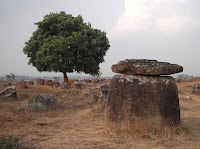I have arranged a homestay with Mr Hung who lives in a village called Thuong Thanh in Can Tho. Can Tho is in the south of Vietnam, in the Mekong Delta where life slowly revolves around the river. Mr Hung’s house is set right next to the river and he’s built some little wooden bungalows for his guests to stay in.
It’s idyllic. We are cooked the most delicious elephant ear fish (the local specialty) lunch by Hung’s family, after which we borrow some bicycles to traverse the riverside village’s paths, which are over hung by numerous fruit trees and flowers; mangoes, jackfruit, bananas and coconuts abound along with rose apples and star apples. It’s a beautiful setting and such a warm atmosphere; everybody waves hello as we cycle by and at one school a whole class stands up in their classroom, waving and squealing ‘hello hello hello’! I feel special.
After a restless sleep listening to the ‘tranquil’ sounds of the river; dogs
barking, chickens squawking and geckos chirping, I rise just before 6 to visit Cai Rang floating market with Mr Hung. Many tourists come to see the famous floating
markets of the Mekong but we’re early enough not to run into them although it’s still very lively. Farmers bring their produce here to sell to traders who carry it out to the surrounding villages and towns. There’s large boats filled to the brim with all kinds of fruit and vegetables; pineapples, potatoes, pumpkins, yams, turnips, carrots, watermelons. . . the list is endless. The sellers tie a sample of their produce to a long pole extending above the boat to advertise what their selling and traders paddle around them filling their longboats with a selection of fruit and vegetables to sell on. It’s a fascinating scene and the river looks alive and magical in the early morning sunlight.
 Mr Hung also takes us on a tour to visit a rice noodle factory, a vegetable seedling nursery, a watermelon farm and a rice factory. We get a glimpse of everyday life in the Mekong delta and it’s fabulous. All the people seem so content in their simple work, they are humble and happy. They also make you wonder if a life like this isn’t better than one in a big city where banks and new shoes and offices rule the day. Mr Hung charges $12 a night at his homestay including dinner and breakfast. It’s more for the personal tour but it was definitely worth it! You can make a booking with him directly at hunghomestay@yahoo.com.vn or on 84903849881.
Mr Hung also takes us on a tour to visit a rice noodle factory, a vegetable seedling nursery, a watermelon farm and a rice factory. We get a glimpse of everyday life in the Mekong delta and it’s fabulous. All the people seem so content in their simple work, they are humble and happy. They also make you wonder if a life like this isn’t better than one in a big city where banks and new shoes and offices rule the day. Mr Hung charges $12 a night at his homestay including dinner and breakfast. It’s more for the personal tour but it was definitely worth it! You can make a booking with him directly at hunghomestay@yahoo.com.vn or on 84903849881.































